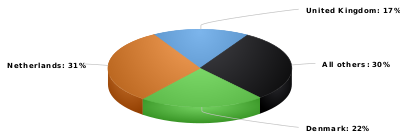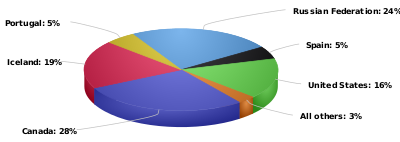Plaice


Plaiceis a common name for a group offlatfishthat comprises four species: theEuropean,American,Alaskanandscale-eye plaice.
Commercially, the most important plaice is theEuropean.The principal commercial flatfish in Europe, it is also widely fished recreationally, has potential as an aquaculture species, and is kept as an aquarium fish. Also commercially important is theAmerican plaice.
The termplaice(pluralplaice) comes from the 14th-century Anglo-Frenchplais.This in turn comes from the lateLatinplatessa,meaning flatfish, which originated from theAncient Greekplatys,meaning broad.[1]
Plaice species
[edit]European plaice
[edit]
| External image | |
|---|---|
TheEuropean plaice(Pleuronectes platessa) is a right-eyedflounderbelonging to the familyPleuronectidae.It is a commercially important flatfish that lives on the sandy bottoms of the European shelf. It ranges geographically from theBarents Seato theMediterranean.European plaice are characterised by their smooth brown skin, with distinctive red spots and a bony ridge behind the eyes. They feed onpolychaetes,crustaceansandbivalvesand can be found at depths of up to 200 metres. At night they move into shallow waters to feed and during the day they bury themselves in the sand. Their maximum recorded length is 100 cm (39 in) and maximum reported age 50 years.[3]
Together withsole,European plaice form a group offlatfishthat are the most important flatfish in Europe.[4]European plaice have been fished from theNorth Seafor hundreds of years. They are usually fished frombeam trawlers,otter trawlersorseiners.[5]In theCeltic Seathe plaice species is consideredoverfished.[6]

American plaice
[edit]
| External image | |
|---|---|
Like the European plaice, theAmerican plaiceis a right eyed flatfish belonging to the familyPleuronectidae.American plaice are an Atlantic species,[9]which range from southernLabradortoRhode Island.They are also found in Europe, where they are called rough dab or long rough dab. They spawn in theGulf of Maine,with peak activity in April and May. They are brown or reddish, and are generally smaller than European plaice, with a rougher skin and larger scales. Their maximum recorded length is 82.6 cm (32.5 in), and maximum reported age 30 years. They are usually found between depths of 90 and 250 m (300 and 820 ft) on sandy bottoms with temperatures between −0.5 and 2.5 °C (31.1 and 36.5 °F). They feed on small fishes and invertebrates.[10][11]
The species is considered by the Northwest Atlantic Fisheries Organization to be overfished, with no signs of recovery.[12]Though they are also currently endangered in Canada due tooverfishing,[13]the Canadian government believes the species is abundant. Flatfish, as a group, are second-most caught (by weight) only to cod in Canada, with American plaice accounting for 50 percent of all flatfish caught.[14]
American plaice may be anintermediate hostfor the nematode parasiteOtostrongylus circumlitis,which is alungwormofseals,primarily affecting animals less than 1 year of age.[13]

Alaska plaice
[edit]Alaska plaice can live for up to 30 years and grow to 60 cm (24 in) long, but most that are caught are only seven or eight years old and about 30 cm (12 in).[16]
Most commercialfisheriesdo not targetAlaska plaice,but many are caught asbycatchbycommercial trawlerstrying to catch other bottom fish. Thus, many Alaska plaice get caught anyway — so much so that, for example, the 2005 total allowable catch in theBering SeaandAleutian Islandsmanagement area (BSAI) was reached before the end of May of that year.[citation needed]
Scale-eye plaice
[edit]Thescale-eye plaiceis aflatfishof the familyPleuronectidae.It is ademersalfish that lives at depths of 18 to 900 m (59 to 3,000 ft). It can reach 46 cm (18 in) in length and can weigh up to 1.2 kg (2.6 lb). Its native habitat is thenorthern Pacific,primarily from theSea of OkhotsktoJapanandKorea,though it is also found in theBering Sea.[17]
Current conservation and management status
[edit]Plaice, along with the other major demersal fish in theNorth Seasuch ascod,monkfishandsole,is listed by theICESas "outside safe biological limits." Moreover, they are growing less quickly now and are rarely older than six years, whereas they can reach forty.[18]TheWorld Wide Fund for Naturesays that in 2006 "of the eight plaice stocks recognised by ICES, only one is considered to be harvested sustainably while three areoverexploited.Data is insufficient to assess the remaining stocks; however, landings for all stocks are at or near historical lows. "[19]
In cuisine and culture
[edit]In North German andDanish cuisine,plaice is one of the most commonly eaten fish. Filleted, battered, and pan-fried plaice is popular hot or cold as anopen sandwichtopping together withremouladesauce and lemon slices. Battered plaice is often served hot withfrench friesand remoulade sauce as a main dish; thisfish and chipsvariant is popular[20]and is commonly available on children's menus in Danish restaurants. Breaded frozen plaice, ready to be baked or fried at home, are readily available in supermarkets. Fresh plaice is also oven-baked.
"The flesh of plaice is white, tender and subtle-flavoured."[5]
Smokedplaice is one of the traditional summer time delicacies ofHiiumaaisland.[citation needed]
Notes
[edit]- ^"Plaice".Webster's New World College Dictionary.Wiley Publishing. 2009.
- ^FAO:Species Fact Sheets:Pleuronectes platessa,Retrieved 23 November 2009.
- ^Froese, Rainer;Pauly, Daniel (eds.)."Pleuronectes platessa".FishBase.November 2009 version.
- ^ European plaice and sole[permanent dead link]World Wide Fund for Nature.Retrieved 22 November 2009.
- ^ab"Plaice".MSC.org.Marine Stewardship Council.Retrieved22 November2009.
- ^Hogan, C. Michael (2011)."Celtic Sea".In Saundry, P.; Cleveland, C. (eds.).Encyclopedia of Earth.Washington, DC: National Council for Science and the Environment.
- ^FAO Nominal Catches ofPleuronectes platessaFishBase,Retrieved 23 November 2009
- ^FAO:Species Fact Sheets:Hippoglossoides platessoides,Retrieved 23 November 2009.
- ^"Plaice".Grolier Encyclopedia of Knowledge.Vol. 15. Grolier Inc. 1991.ISBN0-7172-5300-7.
- ^Dery, L. M."Species Information: American plaice".nefsc.noaa.gov.Fishery Biology Program, Woods Hole Massachusetts Laboratory, National Marine Fisheries Service, Northeast Fisheries Science Center. Archived fromthe originalon 2007-03-11.Retrieved2007-01-18.
- ^Froese, Rainer;Pauly, Daniel (eds.)."Hippoglossoides platessoides".FishBase.November 2009 version.
- ^"Plaice Fishery Recent Assessment".nafo.int.Northwest Atlantic Fisheries Organization. 2005–2006. Archived fromthe originalon 2007-06-07.Retrieved2007-01-19.
- ^abBergeron, et al. 1997.Canadian Journal of Zoology75: 1364-1371.
- ^"American Plaice".Underwater World.Fisheries and Oceans Canada. Archived fromthe originalon 2007-02-04.Retrieved2007-01-19– via dfo-mpo.gc.ca.
- ^"FAO Nominal Catches ofHippoglossoides platessoides".FishBase.Retrieved23 November2009.
- ^Froese, Rainer;Pauly, Daniel (eds.)."Pleuronectes quadrituberculatus".FishBase.November 2009 version.
- ^Froese, Rainer;Pauly, Daniel (eds.)."Acanthopsetta nadeshnyi".FishBase.November 2009 version.
- ^Clover, Charles. 2004.The End of the Line: How overfishing is changing the world and what we eat.Ebury Press, London.ISBN0-09-189780-7
- ^"European plaice and sole"
- ^"Fish & chips".Seafish.org.Archived fromthe originalon 2008-10-11.
References
[edit]- Rijnsdorp, A.D.(1991) Changes in fecundity of female North Sea plaice (Pleuronectes platessa) between three periods since 1900. ICES Journal of Marine Science;48:253-280
- Wimpenny, R.S.(1953)The plaicebeing the buckland lectures. Publisher Edward Arnold
- Gibson, R.N.(2004)Flatfishes: Biology and Exploitation.Blackwell Publishing
- Clover, Charles. 2004.The End of the Line: How overfishing is changing the world and what we eat.Ebury Press, London.ISBN0-09-189780-7
- 1998 Marine Fisheries Review article
- Bulletin announcing reaching the total allowable catch of Alaska plaice for 2005(National Marine Fisheries Service)
External links
[edit]- Guide to Responsible Sourcing of Plaice - produced by Seafishhttps://web.archive.org/web/20071008001434/http://www.seafish.org/upload/file/fisheries_management/Plaice%20Factsheet2%20%20final.pdf







